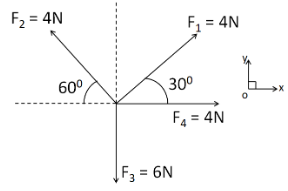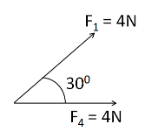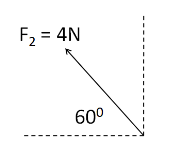
Write down the components of four forces $ {\vec F_1} $ , $ {\vec F_2} $ , $ {\vec F_3} $ and $ {\vec F_4} $ along ox and oy directions as shown in the figure.


Answer
554.4k+ views
Hint : To solve this question, we have to consider the inclination angle of all the forces with reference to the ox direction. The component along ox will be obtained by multiplying cosine of the inclination, and that along oy will be obtained after multiplying sine of the inclination with the magnitude of the force.
Complete step by step answer
As we have to take the components of the forces along ox and oy directions, so we take these directions positively.
Now, for the first force $ {\vec F_1} $ :

The magnitude of $ {\vec F_1} $ is equal to $ 4N $
Therefore, the component of $ {\vec F_1} $ along ox is
$ {F_{1ox}} = 4\cos {30^ \circ } $
$ \Rightarrow {F_{1ox}} = 2\sqrt 3 N $
And the component f $ {\vec F_1} $ along oy is
$ {F_{1oy}} = 4\sin {30^ \circ } $
$ \Rightarrow {F_{1oy}} = 2N $
For the second force $ {\vec F_2} $ :

The magnitude of $ {\vec F_2} $ is equal to $ 4N $
Therefore, the component of $ {\vec F_2} $ along ox is
$ {F_{2ox}} = - 4\cos {60^ \circ } $
$ \Rightarrow {F_{2ox}} = - 2N $
And the component f $ {\vec F_1} $ along oy is
$ {F_{2oy}} = 4\sin {60^ \circ } $
$ \Rightarrow {F_{2oy}} = 2\sqrt 3 N $
For the third force $ {\vec F_3} $ :

The magnitude of $ {\vec F_3} $ is equal to $ 6N $ .
Therefore, the component of $ {\vec F_3} $ along ox is
$ {F_{3ox}} = 6\cos {90^ \circ } $
$ \Rightarrow {F_{3ox}} = 0N $
And the component f $ {\vec F_3} $ along oy is
$ {F_{3oy}} = - 6\sin {90^ \circ } $
$ \Rightarrow {F_{3oy}} = - 6N $
For the fourth force $ {\vec F_4} $ :

The magnitude of $ {\vec F_4} $ is equal to $ 4N $ .
Therefore, the component of $ {\vec F_3} $ along ox is
$ {F_{4ox}} = 4\cos {0^ \circ } $
$ \Rightarrow {F_{4ox}} = 4N $
And the component f $ {\vec F_3} $ along oy is
$ {F_{4oy}} = 4\sin {0^ \circ } $
$ \Rightarrow {F_{4oy}} = 0N $ .
Note
We need to take proper care of the positive and the negative signs of the forces while writing the components. For this, it is always convenient to choose the reference positive direction of the x and the y axis as we have chosen in the above solution. We could also consider the angles of all the forces with the ox directions, to mathematically get the correct signs of the components.
Complete step by step answer
As we have to take the components of the forces along ox and oy directions, so we take these directions positively.
Now, for the first force $ {\vec F_1} $ :

The magnitude of $ {\vec F_1} $ is equal to $ 4N $
Therefore, the component of $ {\vec F_1} $ along ox is
$ {F_{1ox}} = 4\cos {30^ \circ } $
$ \Rightarrow {F_{1ox}} = 2\sqrt 3 N $
And the component f $ {\vec F_1} $ along oy is
$ {F_{1oy}} = 4\sin {30^ \circ } $
$ \Rightarrow {F_{1oy}} = 2N $
For the second force $ {\vec F_2} $ :

The magnitude of $ {\vec F_2} $ is equal to $ 4N $
Therefore, the component of $ {\vec F_2} $ along ox is
$ {F_{2ox}} = - 4\cos {60^ \circ } $
$ \Rightarrow {F_{2ox}} = - 2N $
And the component f $ {\vec F_1} $ along oy is
$ {F_{2oy}} = 4\sin {60^ \circ } $
$ \Rightarrow {F_{2oy}} = 2\sqrt 3 N $
For the third force $ {\vec F_3} $ :

The magnitude of $ {\vec F_3} $ is equal to $ 6N $ .
Therefore, the component of $ {\vec F_3} $ along ox is
$ {F_{3ox}} = 6\cos {90^ \circ } $
$ \Rightarrow {F_{3ox}} = 0N $
And the component f $ {\vec F_3} $ along oy is
$ {F_{3oy}} = - 6\sin {90^ \circ } $
$ \Rightarrow {F_{3oy}} = - 6N $
For the fourth force $ {\vec F_4} $ :

The magnitude of $ {\vec F_4} $ is equal to $ 4N $ .
Therefore, the component of $ {\vec F_3} $ along ox is
$ {F_{4ox}} = 4\cos {0^ \circ } $
$ \Rightarrow {F_{4ox}} = 4N $
And the component f $ {\vec F_3} $ along oy is
$ {F_{4oy}} = 4\sin {0^ \circ } $
$ \Rightarrow {F_{4oy}} = 0N $ .
Note
We need to take proper care of the positive and the negative signs of the forces while writing the components. For this, it is always convenient to choose the reference positive direction of the x and the y axis as we have chosen in the above solution. We could also consider the angles of all the forces with the ox directions, to mathematically get the correct signs of the components.
Recently Updated Pages
Why are manures considered better than fertilizers class 11 biology CBSE

Find the coordinates of the midpoint of the line segment class 11 maths CBSE

Distinguish between static friction limiting friction class 11 physics CBSE

The Chairman of the constituent Assembly was A Jawaharlal class 11 social science CBSE

The first National Commission on Labour NCL submitted class 11 social science CBSE

Number of all subshell of n + l 7 is A 4 B 5 C 6 D class 11 chemistry CBSE

Trending doubts
What is meant by exothermic and endothermic reactions class 11 chemistry CBSE

10 examples of friction in our daily life

One Metric ton is equal to kg A 10000 B 1000 C 100 class 11 physics CBSE

1 Quintal is equal to a 110 kg b 10 kg c 100kg d 1000 class 11 physics CBSE

Difference Between Prokaryotic Cells and Eukaryotic Cells

What are Quantum numbers Explain the quantum number class 11 chemistry CBSE




